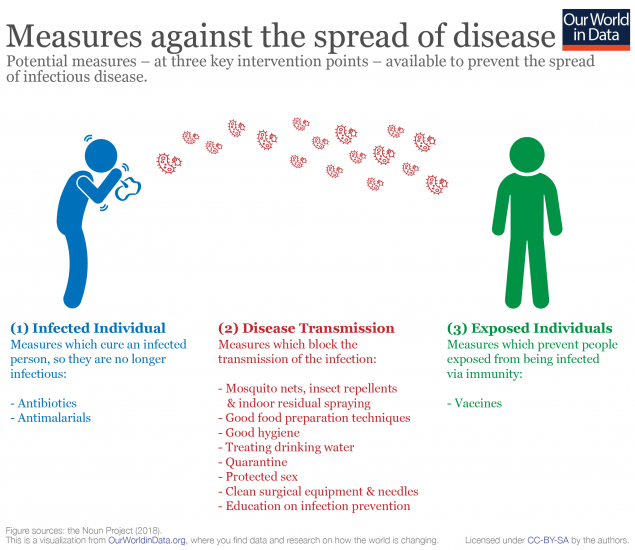Before answering this question, it is important to understand what exactly eradication entails, especially in contrast to the elimination of a disease. While the eradication of a disease is permanent and global, the elimination of a disease is an achievement restricted to a specific geographic area such as a country or continent.
It is not possible to clearly draw a line between eradicable and non-eradicable diseases. Diseases only become eradicable after scientific discoveries give us the tools to fight them. Smallpox was a disease that killed millions every year and it was the discovery of the vaccine that gave humanity the tool to fight the disease and eradicate it completely. [See our entry on Smallpox for the full story.]
However two conditions are absolutely necessary for a disease to be eradicable and there are several characteristics of diseases which make it more likely for a disease to be eradicable.
1. It has to be an infectious disease. This means you can “catch” it from other humans or animals. Non-infectious diseases, such as heart disease or cancer, cannot be eradicated.
2. Measures to fight against the disease have to exist. The appropriate measure to fight the disease depends on the type of pathogen and the way of transmission. For instance, antibiotics only work against bacteria, whilst anti-retrovirals only work against retroviruses. The way the disease is transmitted matters as well: if diseases spread via drinking water, filtering can stop the disease; if spread via mosquitoes, bed nets can stop the disease, etc.
These measures to fight against infectious diseases can be grouped into three categories, which are summarized in the figure. Measures can either target infected individuals, the transmission channel or exposed individuals that are yet to be infected.
The appropriate measure depends on the specific disease. Both smallpox and rinderpest were eradicated using vaccines. However, vaccines have not been developed against every disease, so other methods like water decontamination, wound treatment and health education to block transmission can be used with great success as well – this is for example the measure to fight Guinea Worm disease.
The second condition above means that whether an infectious disease is eradicable or not can change over time. With new breakthroughs in science, new measures to fight the spread of an infection can become available. This can transform a disease that was not previously eradicable into one which could be.
Before the invention of a potent vaccine against the poliovirus by Jonas Salk in 1955 (see our Polio entry for more detail), measures against polio were not effective enough to possibly think about eradication. They comprised better hygiene conditions, such as a flush toilet or safe drinking water, which could contain the spread but were not powerful enough to regionally eliminate, let alone globally eradicate, polio.
The invention of a vaccine, however, made polio an eradicable disease. The chart shows that since 1981, polio incidence has been reduced by 99.99% to 46 paralytic cases in 2016.1 The eradication of polio is now clearly a possibility and would be a major achievement in global health.
In addition to the two necessary conditions above, in our entry we also discuss five features that make eradication more likely. These include:
- The disease is caused by only a small number of pathogens
- The disease has only one host
- The disease is visible and good diagnostics exist
- Elimination has already proven possible
- The perceived disease burden is high and financial, political and community support are available
In our entry, we also discuss the following diseases in more detail (including the characteristics that make them eradicable):
- Smallpox and rinderpest, the two diseases that have already been eradicated [jump to section];
- Polio, Guinea worm, and yaws, three of the diseases we could eradicate [jump to section]


